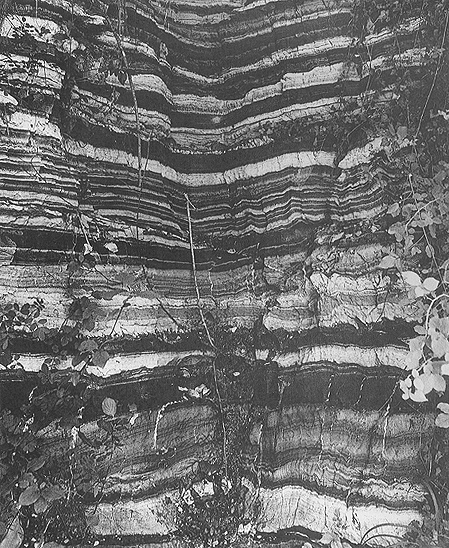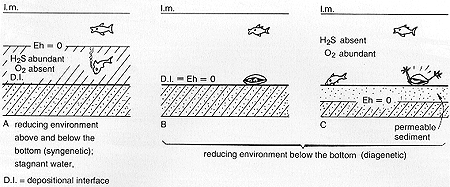

Rhythmic stratification in fallout deposits
Plate 59


Rhythmic stratification in fallout deposits
Plate 59
The bedding in this outcrop is enhanced by color contrasts superimposed on lithologic variations. In cases like this, the terms band for thin bed or lamina, and banded deposits in general, are often used. Strong differences in color or hue of sediments sometimes reflect only subtle changes in composition and texture: small amounts of pigments are, in many cases, sufficient to produce neat colors.
The bands in the picture vary in thickness from nearly 10 cm (white one at the base) to 1-2 mm. A question that can be asked is whether they represent depositional units of variable thickness but of the same rank (beds or laminae) or units organized in different hierarchical levels (laminae, beds, layers, bedsets). In other terms: do the thin bands represent small, independent events or momentary pulsations of a larger event? Answer is not easy in the present case. Some thick white bands have a sharp base and top, and should represent distinct beds (faint laminae inside confirm this impression). More problematic are the intermediate and thin bands. If you look at the lithology, three lithotypes are recognizable: 1) white, crystalline (saccharoidal) gypsum; 2) black shale rich in organic matter (kerogen, or bitumen), and sparse gypsum crystals not visible to the naked eye; 3) gypsum with clayey and organic impurities (various shades of gray).
The fallout of gypsum particles is part of the evaporitic process, starting with the nucleation of crystals at the air-water interface when concentration of salts in seawater is concentrated by strong evaporation. To complicate things, there is the possibility of the crystals (which form a sort of mush on the bottom) being reworked and redeposited. Gypsum beds could thus represent either (or both) primary precipitates or clastic deposits (gypsum arenites and gypsum pelites if sand or mud size particles prevail respectively). It can be hypothesized, for example, that the thinner bands, rhythmically alternating with the black shales, derive from direct evaporitic precipitation, probably seasonal (varves ), whereas the thicker units are made of resedimented gypsum crystals and fragments. Fallout is anyway the dominant mechanism, because reworked particles apparently traveled in suspension.
In any case, gypsum deposition was not a continuous process but a periodic or sporadic one. It was hosted in a tranquil, protected environment, occupied by stagnant water. Conservation of organic matter tells us that oxygen was not present on the bottom (anoxic conditions), as confirmed also by the absence of organic activity. The lack of oxygen implies scarcity or absence of bottom ventilation and water circulation. Furthermore, the abundance of organic matter means that surface waters were affected by eutrophication, i.e., high production of biomass, mostly represented by phyto and zooplankton, favored by a high supply of chemical nutrients. An abundant production of biomass obviously means a mass mortality and a high sedimentation rate of organic remains.
Now, if one assumes that the nutrient input was associated with an influx of fresh water from rivers or of seawater of normal salinity, causing also a dilution of salts in the basin, it is easy to explain the alternation of conditions favorable to deposition of mud and organic matter on one side, evaporitic gypsum on the other.
Messinian evaporites (Gessoso-solfifera Formation) of northern Apennines, Perticara area.
The fallout mechanism does not produce particular structures, if bedding is excluded. In normal cases, it involves muddy sediment and tends to drape previous deposits. Fallout of mud can proceed at a slow pace, particle by particle, or be quickened by aggregation of individual particles and flocculation . Mud beds are texturally uniform or subtly graded. Porosity, and hence the water content in muds, is higher than in sands; initial porosity, however, is greatly reduced by burial and compaction: with increasing overburden, water is squeezed out of the sediment, whose density increases. Muds are commonly rich in clay minerals, which mostly occur as tiny, platy particles; other flat particles of larger size can be present, such as mica flakes and vegetal matter. All of them are originally deposited in a haphazard fashion (like a castle of cards), giving an isotropic fabric; during compaction, they tend to be aligned parallel to the bottom (i.e., normal to the gravity force). An oriented fabric develops, and the sediment acquires an aspect that can vary from foliaceous to scaly to laminated. Compacted, laminated muds become shales, or fissile mudstones. Fissility is a secondary property, related to diagenesis, but sometimes overprints a primary lamination (if organisms did not destroy it).
A thick fallout deposit with a homogeneous texture is not easily interpretable; it could derive either from a massive, instantaneous event, such as mud flow, or from a slow settling lasting for a long time in physically stable conditions, such as the descent of plankton remains in the quiet bottom of the deep ocean. Moreover, the structureless character of a thick pelitic bed is not necessarily related to deposition. It could be secondary, as mechanical (liquefaction) or biological disturbances might have canceled lamination or bedding.